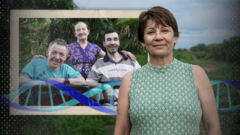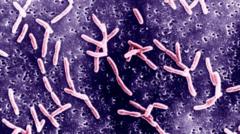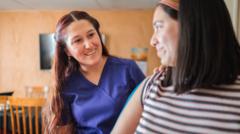Serrinha dos Pintos has long been home to a genetic mystery impacting nearly every family, but it took the determination of geneticist Silvana Santos to bring the elusive Spoan syndrome to light and aid in the diagnosis and understanding of this hereditary disease.
The Hidden Genetic Legacy of Serrinha dos Pintos: A Journey to Diagnosis

The Hidden Genetic Legacy of Serrinha dos Pintos: A Journey to Diagnosis
In a remote Brazilian town where familial ties run deep, a geneticist uncovers a rare condition affecting local children.
In the northeastern Brazilian town of Serrinha dos Pintos, hidden within its lush landscapes, resides a complex web of familial relationships that has left many of its residents grappling with a rare condition known as Spoan syndrome. For years, local families watched their children struggle to walk and grasp the simplest tasks—all while unaware that they were bound by genetics. Geneticist Silvana Santos's arrival over two decades ago marked a turning point for the nearly 5,000 inhabitants, as she embarked on an investigation to unravel the enigma of this debilitating disease.
Before Santos's research came to light in 2005, the syndrome—which is characterized by a genetic mutation affecting the nervous system—was a mystery. The condition manifests only when both parents pass down the altered gene, and until Santos's intervention, residents had no diagnosis to cling to, much less understanding of its implications. "She gave us a diagnosis we never had. After the research, help came: people, funding, wheelchairs," recalls Marquinhos, a patient affected by the syndrome.
Serrinha dos Pintos's geographical isolation has contributed to a high prevalence of consanguineous marriages, where nearly a third of couples are related. This cultural norm, despite posing risks for genetic anomalies, has helped foster tight-knit familial bonds. While the risk of a genetic disorder in unrelated couples stands at 2-3%, for cousins, this risk rises to about 5-6%, creating a potential breeding ground for conditions like Spoan. Santos's earlier studies indicated that this phenomenon, exacerbated by limited migration and genetic sharing, has led to increased instances of disability in children.
Driven by a commitment to the families of Serrinha, Santos dedicated years to her study, often traveling back and forth across 2,000 kilometers from São Paulo, gathering DNA samples and entering the lives of those affected. The culmination of her efforts shed light on the mutation's origins, tracing it back to early European settlers, notably those from the Iberian Peninsula, a link that resurfaces in modern cases found in places as far-flung as Egypt.
As she disseminated her findings, the landscape for those affected by Spoan syndrome began to shift. Awareness led to improved support systems and a more compassionate view towards disabled individuals. Instead of being labeled as "cripples," those with the condition are recognized as individuals with Spoan, helping to mitigate the stigma surrounding disability.
Although there is currently no cure, advances in care—such as the provision of motorized wheelchairs—have significantly improved the quality of life for many. Santos now collaborates with the Brazilian Ministry of Health on initiatives aimed at screening younger couples for genetic risks associated with the syndrome, ensuring that as knowledge about genetics spreads, so too does the understanding of its implications.
Halfway through her visit to Serrinha dos Pintos, Santos reflects on her lasting connection to the town. "It's as if Santos is family," one resident shares, encapsulating the bond forged through shared struggles and shared bloodlines. As her research continues, Santos remains dedicated to empowering families with knowledge, illuminating the shadows of genetic disorders that have, until now, loomed large over their lives.
Before Santos's research came to light in 2005, the syndrome—which is characterized by a genetic mutation affecting the nervous system—was a mystery. The condition manifests only when both parents pass down the altered gene, and until Santos's intervention, residents had no diagnosis to cling to, much less understanding of its implications. "She gave us a diagnosis we never had. After the research, help came: people, funding, wheelchairs," recalls Marquinhos, a patient affected by the syndrome.
Serrinha dos Pintos's geographical isolation has contributed to a high prevalence of consanguineous marriages, where nearly a third of couples are related. This cultural norm, despite posing risks for genetic anomalies, has helped foster tight-knit familial bonds. While the risk of a genetic disorder in unrelated couples stands at 2-3%, for cousins, this risk rises to about 5-6%, creating a potential breeding ground for conditions like Spoan. Santos's earlier studies indicated that this phenomenon, exacerbated by limited migration and genetic sharing, has led to increased instances of disability in children.
Driven by a commitment to the families of Serrinha, Santos dedicated years to her study, often traveling back and forth across 2,000 kilometers from São Paulo, gathering DNA samples and entering the lives of those affected. The culmination of her efforts shed light on the mutation's origins, tracing it back to early European settlers, notably those from the Iberian Peninsula, a link that resurfaces in modern cases found in places as far-flung as Egypt.
As she disseminated her findings, the landscape for those affected by Spoan syndrome began to shift. Awareness led to improved support systems and a more compassionate view towards disabled individuals. Instead of being labeled as "cripples," those with the condition are recognized as individuals with Spoan, helping to mitigate the stigma surrounding disability.
Although there is currently no cure, advances in care—such as the provision of motorized wheelchairs—have significantly improved the quality of life for many. Santos now collaborates with the Brazilian Ministry of Health on initiatives aimed at screening younger couples for genetic risks associated with the syndrome, ensuring that as knowledge about genetics spreads, so too does the understanding of its implications.
Halfway through her visit to Serrinha dos Pintos, Santos reflects on her lasting connection to the town. "It's as if Santos is family," one resident shares, encapsulating the bond forged through shared struggles and shared bloodlines. As her research continues, Santos remains dedicated to empowering families with knowledge, illuminating the shadows of genetic disorders that have, until now, loomed large over their lives.








